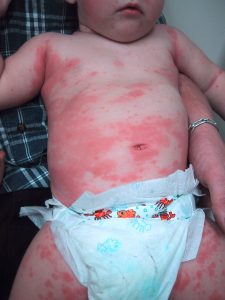The common causes of anaphylaxis include foods such as peanuts, tree nuts, milk, eggs, shellfish, fish and sesame seeds, although many other foods have also been known to trigger anaphylaxis. Some people can react to even tiny amounts of the food. Non-food causes include wasp or bee stings, natural latex (rubber), and certain drugs such as antibiotics. In some people exercise can trigger a serious allergic reaction – either on its own or in combination with other factors such as food or drugs (for example, aspirin). Sometimes the cause of the reaction is not found. This is called “idiopathic anaphylaxis” (cause unknown).
Read our Idiopathic Anaphylaxis factsheets for more information. https://www.anaphylaxis.org.uk/factsheets/

Photo – Thanks to the Anaphylaxis Campaign and Professor Pete Smith © MedicalMediaKits.com
WHAT ARE THE SYMPTOMS OF ANAPHYLAXIS?
Most healthcare professionals consider an allergic reaction to be anaphylaxis when it involves difficulty in breathing or affects the heart rhythm or blood pressure. Any one or more of the following symptoms may be present – these are often referred to as the ABC symptoms:
A – AIRWAY
- persistent cough
- vocal changes (hoarse voice)
- difficulty in swallowing
- swollen tongue
B – BREATHING
- difficult or noisy breathing
- wheezing (like an asthma attack)
C – CONSCIOUSNESS/ CIRCULATION
- feeling light-headed or faint
- clammy skin
- confusion
- unresponsive/unconscious (due to a drop in blood pressure)

Photo – Thanks to the Anaphylaxis Campaign and Professor Pete Smith © MedicalMediaKits.com
If there is a dramatic fall in blood pressure, the person may become weak and floppy and may have a sense of something terrible happening. This may lead to collapse, unconsciousness and – on rare occasions – death. In addition to the ABC symptoms listed above, the following less-serious symptoms may occur: • widespread flushing of the skin • rash (known as hives or urticaria) • swelling of the skin (known as angioedema) anywhere on the body (for example, lips, face). • abdominal (stomach) pain, feeling sick and vomiting These symptoms can also occur on their own. In the absence of the ABC symptoms listed above, the allergic reaction is likely to be less serious, but you should watch carefully in case ABC symptoms develop.
WHY DOES ANAPHYLAXIS OCCUR?
An allergic reaction (including anaphylaxis) occurs when the body’s immune system wrongly identifies a food or substance as a threat. When this happens, the body releases chemicals, such as histamine, in response. It is the release of these chemicals that causes the allergic symptoms.
WHAT IS THE TREATMENT FOR ANAPHYLAXIS?
Adrenaline auto-injectors (AAIs) are prescribed for people at risk of anaphylaxis. Adrenaline is also known as epinephrine, which is its international name. Because anaphylaxis can happen very rapidly, AAIs must be readily available. It is important you carry two, in-date, AAIs with you at all times. Use your AAI if you have any of the ABC symptoms of anaphylaxis above. If in doubt, give adrenaline. A second dose should be given after 5 minutes if symptoms do not improve. After an AAI is used, someone must dial 999 immediately, even if there is improvement. Symptoms may return after a short period and more than one injection may be required. The emergency service operator must be told the person is suffering from anaphylaxis. If the person’s condition worsens after making the first 999 call, a second call to the emergency services should be made to make sure an ambulance is on its way.
Read our Adrenaline factsheet for further information about adrenaline and AAIs.
WHAT SHOULD I DO IF I’M WORRIED MY ALLERGIES MAY BE SERIOUS?
See your GP as soon as possible, even if you are unsure about how serious your allergy is. Your GP can refer you to an allergy clinic for further investigation and allergy testing. Your GP can find allergy clinic information by visiting the British Society for Allergy and Clinical Immunology (BSACI) website: https://www.bsaci.org/find-a-clinic/index.htm For information, a guideline has been issued by the National Institute for Health and Care Excellence (NICE), covering assessment and referral for anaphylaxis.
WHAT WILL AN ALLERGY CLINIC DO?
The clinic will take a detailed history of previous reactions and other allergic conditions you or your child may have, such as asthma, eczema or hay fever. Allergy tests, such as skin prick tests and blood tests, can also provide valuable information. Together, this can help predict the likelihood that a specific food or substance will cause an allergic reaction. They do not predict how serious a reaction might be, but your reaction history can help the doctor decide whether to prescribe AAIs. Occasionally a “food challenge” may be offered to confirm a diagnosis of allergy to a specific food or to rule out food allergy. The person will be asked to eat small amounts of the suspect allergen, gradually increasing the amount. Such tests should only be done in an allergy clinic under controlled conditions. Similarly, a challenge, under carefully supervised conditions, may be needed if you have a suspected allergy to a prescribed drug. This is because the tests currently available may not provide a reliable diagnosis.
WHAT INCREASES THE RISK OF ANAPHYLAXIS?
There are times when you may be at an increased risk of anaphylaxis. These include: • if you have asthma that is poorly controlled • if you are suffering from an infection, or have recently had one • if you exercise just before or just after exposure to the allergen • during times of emotional stress • if you have been drinking alcohol If you are allergic to a food, the amount eaten may also be important – for many people, the more of the food allergen they eat, the higher the risk of anaphylaxis. The way the allergen in the food is prepared and the degree of cooking is also important. For some foods, cooking can reduce the risk of reaction, while for others, the opposite is true.
WHAT CAN I DO TO PROTECT MYSELF OR MY CHILD?
1. If you have asthma as well as allergies, make sure your asthma is well-managed – regular asthma reviews will help with this.
2. If you have been prescribed AAIs, make sure you carry them with you at all times and know how to use them. You should practise regularly with a trainer device. You can order trainer devices for free directly from your AAI manufacturer’s website.
WHAT SHOULD I DO IN AN EMERGENCY?
1. Use your AAI immediately if you have any signs of anaphylaxis. If in doubt, use your AAI.
2. Straight after using your AAI, dial 999 and say anaphylaxis (“ana-fil-axis”).
3. Lie down and raise your legs.
4. If you are struggling to breathe, sit up but don’t change position suddenly. Lie down again as soon as you can.
5. Stay lying down even if you are feeling better.
6. Use your second AAI if symptoms haven’t improved after 5 minutes.
BIPHASIC ANAPHYLAXIS
If you have anaphylaxis, you will need to be observed in hospital after you have recovered. This is because in around 1 in 25 cases, a second “wave” of symptoms can develop. This is referred to as a biphasic reaction. Around half of biphasic reactions occur within 6-12 hours of the initial reaction. Biphasic reactions are less common with food-induced reactions compared to other, non-food triggers.
DOES THE RISK OF ANAPHYLAXIS GET LESS OVER TIME?
There is no evidence that the risk of anaphylaxis gets less over time; however, some people will outgrow their allergies. This is more common in young children, particularly those allergic to cow’s milk, egg and wheat.
WHAT IS MASTOCYTOSIS?
In most cases of anaphylaxis there is a trigger, such as a food, drug or insect sting. However, anaphylaxis can also occur in people who have a very rare condition called mastocytosis. Mastocytosis is caused by too many “mast cells” gathering in the tissues of the body. These are the main cells that release histamine and other chemicals that cause the symptoms of allergic reactions. If you have this condition, it’s important that your doctor identifies mastocytosis as the cause of your symptoms. For further information visit:
http://www.nhs.uk/conditions/Mastocytosis/Pages/Introduction.aspxKEY MESSAGES
• If you suspect you have an allergy, see your GP.
• If you are prescribed AAIs, carry two with you at all times.
• Use your AAI as soon as you notice any signs of anaphylaxis – make sure you know what the signs are so you can act quickly.
• Make sure you know how to use your AAI and get a trainer device from the manufacturer to practise.
• Do your research. If the allergen that affects you is a food, read food labels very carefully every time and ask direct questions wherever food is served.
FEEDBACK
SOURCES
All the information we produce is evidence-based or follows expert opinion and is checked by our clinical and research reviewers. If you wish to know the sources we used in producing any of our information products, please contact
[email protected] and we will gladly supply details.
REVIEWER
The content of this factsheet has been peer-reviewed by Dr Paul Turner, Reader in Paediatric Allergy and Clinical Immunology at the National Heart & Lung Institute, Imperial College, London
DISCLOSURES
We are not aware of any conflicts of interest in relation to the review of this factsheet.
DISCLAIMER
The information provided in this factsheet is given in good faith. Every effort is taken to ensure accuracy. All patients are different, and specific cases need specific advice. There is no substitute for good medical advice provided by a medical professional.
ABOUT ANAPHYLAXIS UK
Anaphylaxis UK is the only UK-wide charity solely focused on supporting people at risk of serious, life-threatening allergic reactions. We provide information and support to people living with allergies through our free national helpline and local support groups. We also campaign and fundraise to achieve our ultimate aim, to create a safer environment for all people at risk of serious allergies. Visit our website www.anaphylaxis.org.uk and follow us to keep up-to-date with our latest news. We’re on Facebook @anaphylaxixUK, LinkedIn, Instagram @anaphylaxisUK, Twitter @AnaphylaxisUK and YouTube.
For more Fact Sheets from Anaphylaxis UK, please click HERE.
The website www.sparepensinschools.uk– a collaboration between the Anaphylaxis Campaign, the BSACI, the RCPCH and Allergy UK – has been set-up to support schools, parents, students and healthcare professionals in implementing the new guidance from the UK Departments of Health to support children with food allergies in schools, and where appropriate, the use of emergency ‘spare’ adrenaline auto-injectors now permitted under UK legislation.

Their factsheets contain a wealth of information about anaphylaxis which is evidence based and checked by clinical experts. Read their ‘Frequently Asked Questions in Schools’ factsheet for more detailed advice and information about allergy management in schools:
www.anaphylaxis.org.uk/our-factsheets.
They also have a free online course called ‘AllergyWise for Parents and Carers of School-age children’ designed to help you improve your knowledge about allergies, get wised up about anaphylaxis and feel more confidently in control of family life. Essential Parent strongly advise you to visit
www.allergywise.org.uk to register.
DISCLAIMER
This article is for information only and should not be used for the diagnosis or treatment of medical conditions. Essential Parent has used all reasonable care in compiling the information from leading experts and institutions but makes no warranty as to its accuracy. Consult a doctor or other health care professional for diagnosis and treatment of medical conditions. For details
click here.



